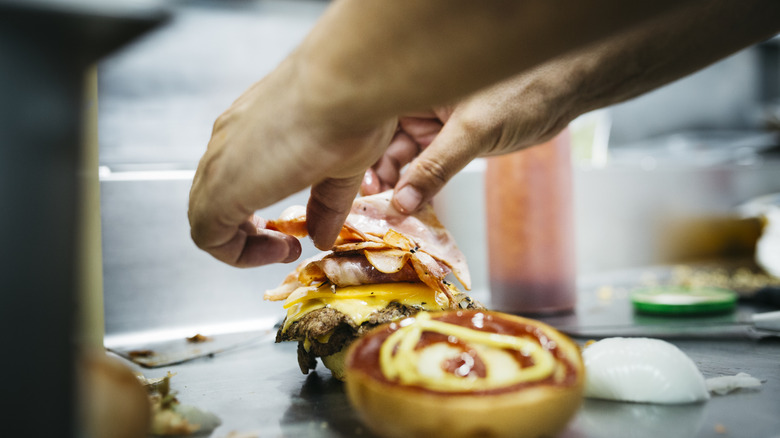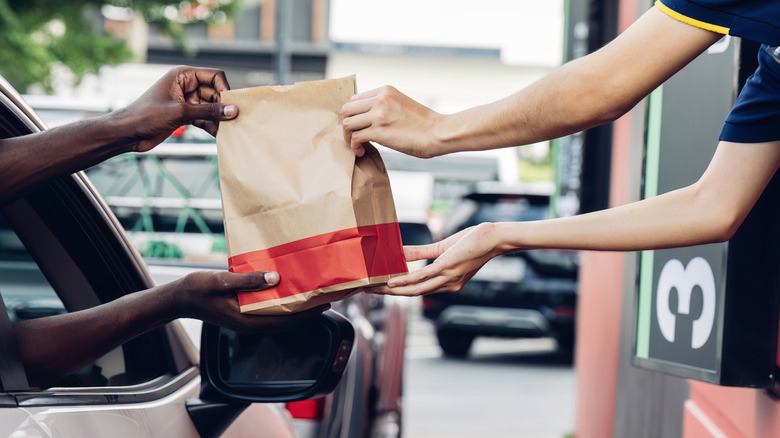Why Fast Food Has Become So Expensive
Whether you're tracking how fast food prices have changed in the last 50 years or in the last six months, the truth remains that fast food is more expensive than ever. It may seem simple to tie the rise in fast food prices to whichever phenomenon leads the headlines of the day. The truth is that there is no single reason for the rise; wage increases, rising costs of produce and eggs, added energy expenses for restaurant owners, and more end up being factored into the price you pay at the drive-thru window. And when the prices jump up unexpectedly, it can be a brain-buster trying to figure out which element is at play. All you know is that the burger and fries are a dollar more than they were yesterday, with no clear explanation offered.
The dynamics that determine fast food pricing are a matrix of forces that play against one another; an unexpected shift from any one of them can directly upset the balance. And as with other financial structures, the results of those shifts end up on the consumer's tray in one form or another. To give you an idea of how many different reasons there can be for why fast food prices are more expensive, here's a rundown of the major costs incumbent upon your favorite restaurants, each of which has a chance of blowing up your dining budget at any given moment.
Ingredient costs
You know all too well the pain of paying more for the food you buy at the grocery store, so it only follows that fast food outlets are paying higher food costs for ingredients, too. The market for elements like lettuce, beef, and eggs have fluctuated wildly in the past several years, creating a whipsaw effect that puts a burden on chains and their franchise owners. In addition to basic cost increases, the possibility of shortages similar to the 2022 lettuce shortage can cause surprising price jumps from suppliers to restaurants, which of course will result in a menu with jacked-up prices to dumbfound unsuspecting diners. These are the moments when consumers switch their standard orders and opt for the cheapest fast food items they can find instead.
Such developments can lead to unethical price-hiking practices in the fast food industry. Some fast food companies continued charging customers higher prices even after their costs eased from an inflationary peak of 9.1% in June 2022. The good news is that customers voted with their dollars by opting out of their usual outlets and places like McDonald's noticed, prompting a resurgence of affordable food. But knowing the company you depend on for your easy going grub is willing to take advantage of you to get a few extra dollars in the register is tough to chew and even tougher to swallow.
Labor costs
One of the most heated debates regarding fast food finances in recent memory is the hourly wage increase for the workers behind the counter. With the legislated minimum wage for fast food employees reaching upwards of $20 an hour in some states, the optics of rising prices assume an easy scapegoat. How can headline after headline announce that fast food outlets now have to pay so much more for labor without drawing the connection to rising menu prices reaching $15 for combo meals that cost half that not so long ago? It's logical to think wage jumps equaling more than $13 an hour in some instances would result in higher food prices, but where and when they impact the menu can be tricky to pin down.
Of course, there will be increases based on the amount a restaurant has to pay out to the people who work there. It can even lead companies to swap out higher quality elements for cheaper processed ingredients to absorb the costs. But if the real reason fast food prices are going up is that the industry has been drastically underpaying its employees for far too long, maybe the public is ready to pay a little more to help the folks cooking and serving their meals see a larger paycheck. Knowing that McDonald's in Denmark is able to pay its workers $22 an hour as a starting wage without drastically increasing its prices makes the claim of labor costs as a reason even more suspect.
Energy expenses
Energy expenses are non-negotiable for a sector of the economy that depends on a constant stream of electricity to stay in operation, and around the clock in some instances. Depending on location, the capricious nature of electric companies and their pricing structures can cause sticker shock for proprietors. The costs restaurants pay for food are calculated in part by the use of electricity in the production, which cause increases in the background that roll forward to the prices on the menu. It's a hidden cost that may not initially occur to the customer, but it's a factor that can throw the basic fast food pricing structure out of whack should the supplier raise its costs to cover increased electrical expenses.
What about the restaurants themselves? According to some estimates, the average restaurant pays between $2,000 and $6,000 for electricity per month, a cost that varies by region and location and can be much higher. Add to that the fact that natural gas prices went up by more than double in the last six months of 2022 alone and you have a wobbly, upward-trending cost structure that has to be relieved somewhere. The valve that keeps your favorite restaurants from closing down due to elevated energy costs is — you guessed it — the prices you pay at the counter. The restaurant has to cook your food and process your payment somehow, and you end up chipping in for the cost with your burger funds.
Higher rents
Not all fast food franchisees own the property their restaurants exist on; many pay rent for the lot and the building, an expense that can fluctuate drastically thanks to an up-and-down real estate market. And the direction rent has been going just about forever is up-up-up, which includes rent for fast food proprietors. With rent prices averaging between $3,000 and $10,000 per month, restaurants have a hefty bill to cover. Any increases to that amount means an influx of cash is needed to stay in business. Sure, it's not your direct issue that rent is going up. But almost nothing you pay for aside from the food is a direct cost to you in the fast food exchange. That doesn't mean you won't pay for it somewhere in the price.
Some estimates note that a restaurant's rent should be no higher than 10% of sales. Imagine a nearby fast food restaurant experiences a $500-per-month rent increase. Calculations for monthly expenses have always worked out based on the stability of their rent, but now they have to come up with extra income. It may not seem like much overall, but the source of all their income is you, and the mechanism that delivers more of your money to cover the rent increase is the price of what you buy. So, when your Mega Meal jumps by 50 cents, you're actually helping defray the costs of keeping the restaurant operating. You deserve at least a few extra fries for your contribution.
Shipping increases
The pandemic introduced the world to the complexities of supply chain mechanics and revealed how tenuous getting fast food ingredients from distributor to kitchen can be. The invisible expenses in this aspect of the fast food game include packaging, transport, processing, and storage, all of which are necessary and any of which can change on short notice. When complications arise in arranging this unending flow of product, new expenses can be added on top of existing charges, which are likely to increase as well. Think about Burger King running out of burger buns thanks to recall from its usual distributor; to keep things flowing smoothly, alternate resources are required, which may involve more expensive product and expedited shipping at a higher cost.
Even when everything is working smoothly, factors such as gas prices, vehicle upkeep, transitioning to more fuel-efficient models, and driver salaries are all tied into the overall expense for shipping necessities to your favorite fast food kitchen. The interconnection of the supply chain is now a paid-for presence you can calculate into what the menu items show in the price column, even if you don't know how it breaks down. It all becomes the reasons why your favorite fast food restaurant can't keep up with inflation, shipping edition. It's something to remember when you pay more at the pump before heading to the drive-thru and paying more there, too.
Franchise and royalty fees
There's a cost to owners of fast food locations that may not be considered as part of the formula by the average customer: franchise fees, the membership money paid by the restaurant to be part of the greater operation. Franchise fees can range from $10,000 for a Chick-fil-A location to $50,000 for a Burger King or Wendy's restaurant. Enterprising proprietors who own a small chain of locations pay that fee for each restaurant, which ups their overall costs. Though the fee is a one-time cost, increases to the amount can add up quickly for an entrepreneur looking to expand.
A more ongoing concern for franchisees who own even a single location is royalty fees, the percentage of sales each franchise location is required to pay to the chain throughout the year. These amounts can range from 4% to 12% and up, depending on the company — a considerable amount even on the lower end of the scale. Even companies with long-time fee freezes like McDonald's have increased their royalty amounts for the first time in three decades. The pressure is on for locations to perform to expectation, and every bit helps. So, when you see basic burgers suddenly costing as much as deluxe burgers used to, you may be helping your preferred location keep its franchise fully functional.
Price gouging
One of the most unethical reasons for fast food price increases is the tendency for some chains to engage in price gouging. This results in unreasonable price increases that take advantage of a precarious situation — a beef shortage, for example — that chains can use as a reason for hiking their prices without warning. Companies that recognize the high demand for its product may be tempted to price gouge to maximize profits, and though the practice seems like a clear legal issue, laws vary from state to state. Even when laws are in place, it can be disappointing for customers to learn that enforcement isn't always enacted, which may leave customers paying more without recourse. And if demand is high enough, consumers may be willing to pay the extra, which feeds the vicious price gouging cycle.
Sometimes, it takes public outcry to get officials to act on fast food price gouging. When profits are made visible for companies like McDonald's and the executives crow about making record numbers while prices continue to soar, there's bound to be a hint of price gouging mentioned in the conversation. With so many customers thinking fast food is overpriced, the quickest way to put a restaurant in check is to take your business elsewhere; often the moment when a draw-down in sales is felt by the higher-ups is the moment when announcements of price drops magically appear to restore customer confidence.
Sneaky marketing
It's always fun and exciting to hear that your favorite fast food outlet is dropping a special lower-priced combo meal. But the truth behind this may be that the company is also raising prices across the board on other items and is using this generous offering as a ruse to distract customers from realizing the truth. The offset for dropping a combo meal to $5 after charging more than twice that has to come from somewhere, even if it's a nickel-and-dime upcharge on the entire suite of products on the menu. After all, you've been paying attention to the prices going up, so why wouldn't you be thrilled to hear they're dropping a little? Because you're smarter than that — that's why.
After too many complaints about rising prices circulated among grumbling customers in recent months, a new value meal war ensued in an attempt to win back diner dollars. The return of the McDonald's Value Meal and Taco Bell's Cravings Value Menu as a generous gift to help make eating out affordable again wouldn't be such a big deal if the price increases on fast food items hadn't gotten so out of hand in the first place. It may seem cynical to think that sometimes restaurants increase prices intentionally in order to seem heroic when they throw the public a $5 bone, but it's a savvy sensibility that even the most die-hard fast food eaters are hip to. Whether it changes their dining habits is a different story.
CEO salaries
CEO salaries in the corporate world never seem to stop growing to breathtaking levels, climbing even during the corporate gear-grinding performance during the 2020 pandemic. As part of the cash grab, fast food companies are shelling out enormous dollars for so-called qualified leaders to keep their stock high and the profits soaring. But the numbers associated with fast food CEO pay are staggering in comparison to worker salaries, and that money has to come from somewhere. No company worth its salt is going to compromise its profit to pay its CEO, which means customers will, in the form of higher prices on the menu board.
For example, McDonald's CEO Chris Kempczinski's salary in 2023 totaled $19.2 million, a combination of cash, bonuses, and stock — and an 8% increase from his 2022 salary. That increase isn't coming out of Ronald McDonald's big yellow pantsuit pocket; it's coming out of your presumably more stylish pocket, and all the other customers who pony up ever-increasing for their McRibs and adult Happy Meals. Sure, these figureheads have a lot to handle, trying to keep an entire company profitable without angering shareholders or customers. But when you see how much they take home for their work, it's much easier to solve the mystery of why upward-creeping fast food prices feels unending.
Delivery apps
The introduction of delivery apps into the food world sounded like a sweet solution for customers. Now you can have your favorite fast food delivered to your door, your desk, your picnic table — wherever you happen to be when the hunger for a Big Mac strikes. Though there are plentiful fees involved in the delivery itself, there are also price increases at fast food restaurants that absorb the extra labor involved in having to cover both in-restaurant and delivery food prep, as well as commissions paid by the restaurants. True that the delivery fees themselves have compounded to include tip and service fees, which just makes the food delivery app costs go even higher. But when the food prices become elevated to compensate for the various companies trying to get a slice of the pie, the customer ends up paying for the luxury.
Another devious way you may see increased fast food prices where apps are involved is the idea of flex pricing, which allows restaurants to feature higher prices through app ordering than in-restaurant ordering. There's also the phenomenon of menu prices differing by location, which is always dicey but becomes more slippery with delivery app pricing in the mix. It isn't too wild to think that user tracking may someday lead to pricing structures that allows users to see different prices, depending on their loyalty and purchase behaviors. It just goes to prove that as pricey as fast food is, it can always get pricier.










